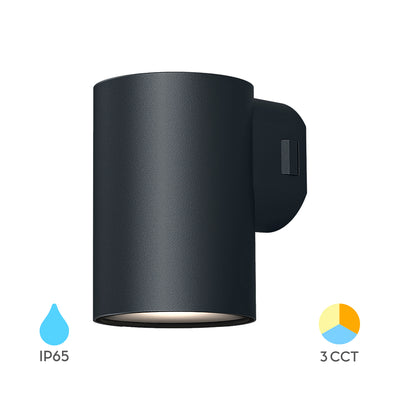
Wall Lights
Outdoor wall lights are a functional and decorative addition to any facade. They provide targeted lighting for the entrance, paths, and terraces, which increases the safety and usability of the outdoor space after sunset. At the same time, they contribute to the overall appearance of your home by accentuating architectural details and creating an inviting ambiance.
Choosing the right wall light: considerations for every situation
The selection of a suitable wall light depends on various factors, such as the desired function, exposure to weather conditions, and aesthetic preference. Below are the important aspects to consider:
Protection against weather conditions: understanding the IP rating
The International Protection (IP) rating is crucial for outdoor lighting and indicates the degree of protection against the ingress of dust and water. It is important to choose the correct IP rating that suits the placement of the light. A higher number indicates better protection.
| IP rating | Protection | Suitable locations |
|---|---|---|
| IP44 | Splash-proof | Under a canopy, veranda, or other sheltered places. |
| IP54/IP55 | Splash-proof and protected against dust | Suitable for most outdoor conditions, including directly on the facade. |
| IP65 | Jet-proof and dust-tight | Directly exposed to rain and wind, for example on a shed or a freestanding wall. |
| IP67/IP68 | Immersion-proof and dust-tight | Very demanding conditions, such as in the ground or near a pond. Less common for wall lights, but important for ground spots. |
Light pattern and light colour: functional or atmospheric?
Wall lights are available with different light patterns and colour temperatures:
-
Light direction:
- Up and downlight: These lights cast light both upwards and downwards along the facade, creating a decorative effect and accentuating architectural elements.
- Full spread: Lights that spread light all around, for example at the front door or matching lights on the side facade, for general illumination of a wider area.
- Directed light: Wall lights with an adjustable light beam to highlight specific elements, such as a house number or plants.
-
Light colour (Kelvin):
- Warm white (2700K - 3000K): This light colour creates a cosy and inviting atmosphere, which is pleasant at the entrance or on a terrace.
- Neutral white (4000K): This type of light provides bright and functional lighting, useful for paths or at a back door.
- Cool white (5000K - 6500K): More suitable for places where maximum visibility is needed, such as near a storage shed or for security purposes.
Practical aspects of installing wall lights
Before installing an outdoor wall light, it is advisable to consider a few practical aspects. Correct installation ensures the safety and durability of the lighting.
Determining location and mounting height
The ideal mounting height for a wall light depends on the desired effect and function. For general lighting along a path, a height of 1.80 to 2.20 metres is often suitable to prevent glare and ensure a wide light spread. At the front door, the light can be placed slightly lower, around 1.60 to 1.80 metres, to properly illuminate the entrance without being blinding. Consider the existing surface (brick, wood, plaster) and ensure you have suitable mounting materials.
Connecting power supply and cabling
Most outdoor wall lights operate on 230V mains voltage. Always ensure the power supply is turned off before you begin the installation. Use outdoor cables that are suitable for the conditions and ensure waterproof connections, for example by using IP-certified terminal blocks or cable glands. If you are connecting multiple wall lights to a single circuit, plan the wiring carefully to ensure an even power supply and prevent overloading.
[reference: Blog article: "Safely connecting outdoor lighting: tips for the DIY enthusiast"]
Wall lights with sensors: convenience and security
Many outdoor wall lights are equipped with built-in sensors for extra functionality:
- Motion sensor: The light switches on automatically when motion is detected. This is useful at the front door, gate, or as part of a security system. The sensitivity and the duration the light stays on are often adjustable.
- Dusk sensor (day/night sensor): This sensor ensures that the light automatically turns on at dusk and off at daylight, which contributes to energy savings and convenience.
Combining both sensors is also possible for an optimal result.
Durability and materials of wall lights
The materials from which outdoor wall lights are made determine their lifespan and maintenance. Materials that are highly resistant to corrosion and UV radiation, such as aluminium, stainless steel, coated steel, and certain plastics, are a wise choice for long-term outdoor use. Stainless steel offers a modern look, while coated aluminium is available in various colours and requires less maintenance.
The future of wall lighting: LED technology
The switch to LED technology has also transformed the world of outdoor wall lights. LED wall lights consume significantly less energy, last longer, and are available in a wide range of designs and light colours. This makes LED the preferred choice for new installations and for replacing older, less efficient light sources.
By carefully considering the function, location, and technical specifications, you can choose an outdoor wall light that enhances both the safety and aesthetics of your outdoor space. The right outdoor lighting creates a welcoming atmosphere and allows you to enjoy your garden and facade for longer.
